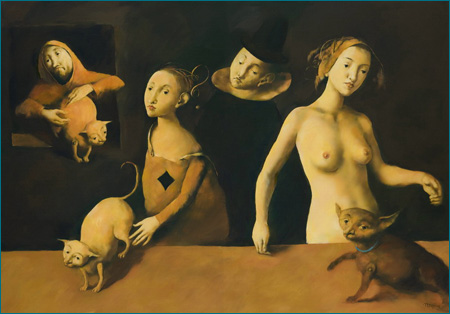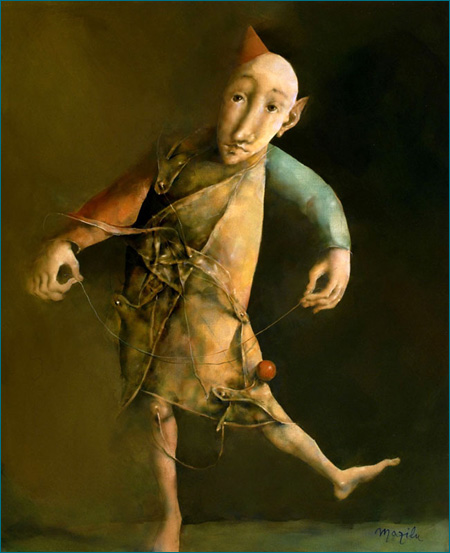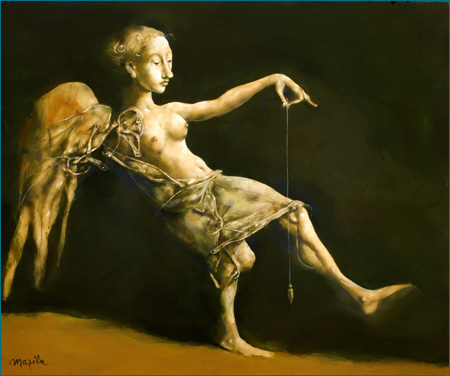 |
When one sees Mazilu’s sketches, these very first pencil lines randomly drawn on the paper, one thinks of that automatic writing which has the magical power to bring forth messages from elsewhere.
In these sketches doodled in a dream-like state, appear creaturess that all have a downward-sloping nose, a sinuous mouth and sad eyes. Transposed onto the canvas, having taken their final shape, they reveal themselves to our questioning.
None of those characters look happy or overjoyed: they are humble, resigned, solitary, enclosed in their thoughts and enigmatic occupations. The relation to the other is sometimes conveyed merely by a vague gesture, a light movement of a fine yarn, of the trajectory of a marble that their eye does not even follow.
In fact, none of them seem to see the other.
Their internalized vision poses in front of reality a screen of memories and melancholy.
|
|
 |

Le comptoir aux chats |
|
Considering their proportions, these beings have the size of children or imps.
They have elves’ ears that look dry, leafy and veined, easily crumpled like paper, their mouths are closed and their faces frowning.
They all look alike, with their fleshy, vulnerable and emotive noses, and with a faraway look in their dark eyes.
Their skull is almost always bald or adorned with scraps of fabrics, bonnets, or small hoods that lead us to believe that the children of their children are born with a head covering.
They sometimes have no legs, no arms. They are replaced by articulated jumping jack legs, roots, old toy wheels, or more simply, their incomplete bodies float in the air.
They put up with these unusual lacking and addition with the habitual resignation.
They were born like that and humbly accept their crippled bodies.
Their artificial limbs are clumsily fastened by transparent basting stitches or knotted and reknotted leather strips.
Membrane strips are laid on them like additional skins which are fastened, buttoned or sewn, although poorly, giving rise to their subsequent, improvised, makeshift repairs. This combination of epidermis and clothes not only cover the bodies, they are part of it.
It seems they have been wearing these rags ever since the beginning of their existence and, stretched, tanned, rolled up, knotted, riveted in places, they have been used by these misshapened bodies as an outer shell holding the whole.
Sometimes added to these rags comes the refinement of a glass bead, an agate, a moonstone: perfectly round, precious and transparent water drops painted with sensitivity.
Young girls wear in their hair spider-like diadems of fine beads and silver yarn.
Traces of light, almost imperceptible, link the space with a character to another, assemble two pieces of fabric or underline the edge of a garment.
|
|
 Clown Clown |
 |
However, these imps, these gnomes, whose bodies are laid out in the most unlikely manner, possess limbs ending with truly human feet and hands. They are too large or too thin, often disproportionate, yet the joints of their knuckles and nails are meticulously drawn.
Their hands are those of pianists, harpists, mimes, with expressive and delicate gestures. More so than the faces themselves, their hands convey their emotions, they design, tell, explain…
They stretch, cross each other and their fingers seem to have conniving and affectionate relationships to each other.
These creatures collect items that are childrens’treasures such as watch dials with mysterious faces, pieces of lace, game cards, pieces of forgotten or discarded cardboard, fabric, marbles, buttons, strings... all those modest treasures may be used for secret games whose rules, invented by a child, are known only to him or herself.
Animals live nearby, confident loving animals that usually don’t seek loving contact from these absent-minded humans with distant gazes.
They have feelings so similar to theirs that their physionomy is often the same.
They have sad, toy-like eyes that surface through a circle of skin.
They, as well, have a long and sensitive nose and that sinuous, closed mouth.
They share the same misadventures as their masters, they are covered with stitches, dislocated and reassembled in an imaginative way, and they sometimes forget about the fact that they are four-legged beings...
These elves have wives similar to themselves. They are subjected to the same transformations, have the same faces and the same sad noses, their companions are slightly grazed by their gestures and their gazes are cast elsewhere.
But, off to the side, is the woman whose perfect nudity has been respected by the painter. She also is dreaming and offers herself, peaceful, to the contemplation and desire of the one who has painted her and the others who are gazing at her.
|
|
Curiously, we are not tempted to pity these beings for their deformities, their deficiencies, because these small creatures are loved, as they give in to the arbitrariness of their creator.
They accept being these kinds of toys which are assembled and disassembled, disarticulated and then recreated with the innocent or sadistic imagination of a child.
Their enigmatic games raise in us some far-away memories of moments of solitude during which we too drew the cabbalistic signs of an occult magic invented from the rites known to ourselves only. But their regard distances itself from grotesque silhouettes in order to contemplate in themselves a sad dream of an adult or of an early mature child.
All these individuals are shut away in an enclosed space. Only once will a window give you a glimpse of the sky. Other openings implacably unfold onto the black. Furniture and objects are rare, oversimplified: a chair, a table, a stool... hardly anything.
Most often, the rooms consist of vaccuum and shadows. The touch is both fluid and light.
There is no impasto but some delicate scumbles that make the underlying colors iridescent with beiges pearled with golden yellows and silky whites. But the color brown dominates.
Some sepia and burnt umber with the warm tone of light ochres. The flesh shows in its surface some shivers colored with old blues, pale pinks and beiges. Bronze patinas cover dead skin, the worn out garment folds, the emaciated tendons and the horn that fringes the leather strips. Lastly, on the clothes and on some of the accessories are found more vivid colors, purer warm blues, almond greens, vermilion combined with red ochre, coppery olive greens, and the peaceful freshness of absolute blacks.
|
What are the relationships of all these beings with their creator?
They are his toys, his puppets, his fancy.
He makes them suddenly appear from nowhere to give them a life, a background. Without him, nobody could have seen them, get to know them and have them inhabit, in turn, his imaginary world.
More deeply, they are the evidence of his power to create and leave the world an ineffaceable trace.
Mazilu has painted an angel that falls over, stetching his arm to recover his balance using a plumb line.
While on the right, his face, his stomach and his chest are enlighted by a lively and warm light, the falling part is emaciated and ligneous,
his wing looks like a dead leaf, shriveled up and dry.
He seems to sum up an aspect of this work in which tenderness, baroque, originality and beauty combine with the fear of loneliness, decay, and death.
|
 |

La chute de l'ange
|
|
 |
| top |
|
|